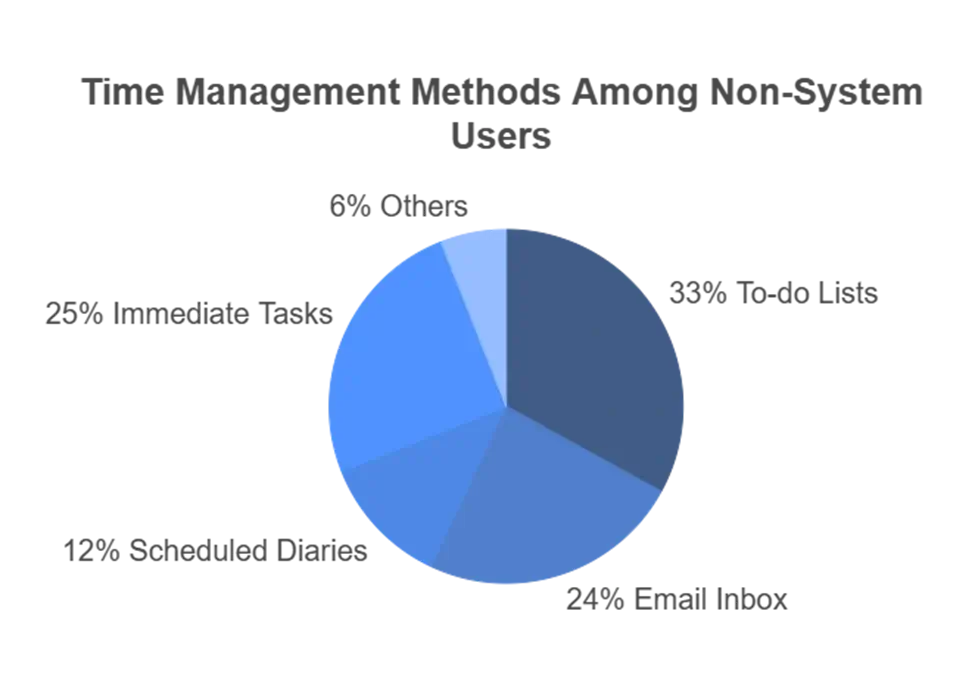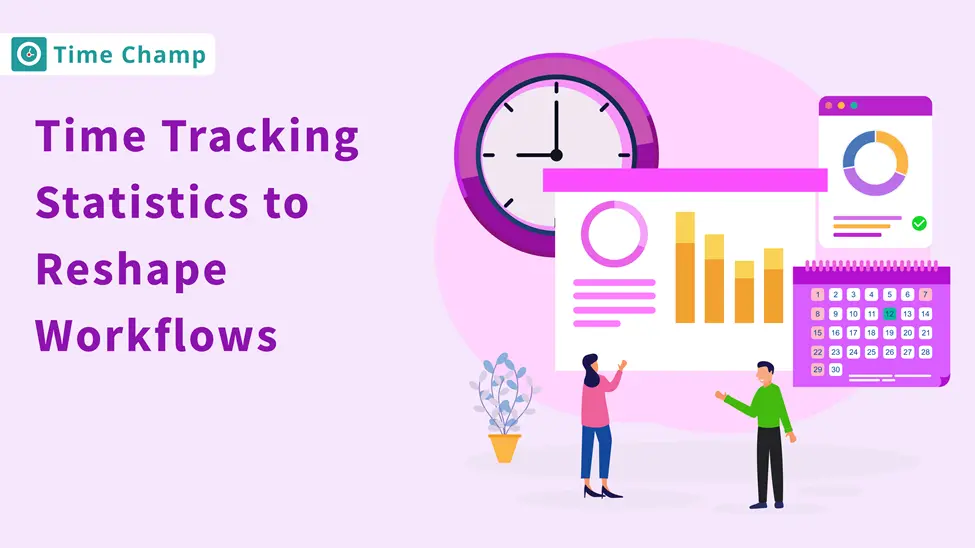Think you're on top of your schedule? The numbers might surprise you. From untracked tasks to constant distractions, more time is lost than expected. Time tracking statistics reveal just how much of the day slips through the cracks. This article breaks down the data and shows how small changes can lead to major productivity gains.
The Business Impact of Time Tracking
Until we can manage time, we can manage nothing else.--Peter Drucker.
This quote sums up what time in business is all about, it is not just a resource but the spine of performance and profitability. When time is not managed correctly, everything else is affected. Knowing how it's tracked and used can drive smarter decisions and better results.
Here are the important statistics that reflect the real outcome of time tracking on the success of the business:
1. Rapid Growth of the Time Tracking Software Market
The time tracking software a market across the world is witnessing strong growth and is set to grow from $3.35 billion in 2024 to $3.93 billion in 2025 with a compound annual growth rate (CAGR) of 17.5%. This spike is due to such factors as automation, digitalization, and the growing tendency to work remotely.
2.Time Theft Costs Businesses $400 Billion a Year
Time theft is a pervasive problem affecting a vast majority of businesses. According to The Insight Partners, more than 75% of U.S. firms are affected by time theft, which can consume up to 7% of total annual gross payroll. This problem occurs when employees are paid for time that they did not spend working, either through rounding of hours, excessive breaks, or cases of “buddy punching”, where one employee clocks in for another.
3. 82% of People Don’t use a Proper Time Tracking System

- Only 18% of people use a specified time management system.
82% of people do not employ any formal time management system.
Among those without a dedicated system:
- 33% rely on to-do lists to manage their tasks.
- 24% use their email inbox as a task management tool.
- 12% schedule all tasks in their diaries in advance.
25% of them deal with tasks that are immediately important, without an ordered approach.
The findings are an indication of a lack of adoption of efficient time tracking and management systems that have the potential to interfere with workplace productivity and task control.
Employee Perspectives: Productivity, Accountability, and Satisfaction
Here are the time tracking statistics from Gitnux, that uncover how time is spent and where improvements can be made. Such numbers will help understand efficiency, which is vital for increased concentration, output, and overall performance.

4.Enhancing Employee Well-being and Preventing Burnout
- In surveys, 41% of workers report that workloads are too intensive and leads to stress and lower efficiency.
- About 55% of employees suffer from burnout, and this normally results from a lack of proper time management alongside long-term working pressure.
- 39% of the professionals spend more than 60 hours a week, which increases the chances of experiencing burnout and inefficiency.
- Proper task prioritization can mitigate the stress of work up to 30%.
- Using a to-do list helps streamline focus and reduces stress by 35%.
- Incorporating mindfulness exercises into daily routines can improve focus and boost productivity by 15%.
5.Rethinking Meetings: From Time Wasters to Time Well Spent
- The average employee takes part in 62 meetings monthly, though 31% of it is considered to be completely useless.
- This means that approximately half of all meetings do not add value, signaling a dire need for critical scheduling decisions.
- Employees spend approximately 6 hours in unproductive meetings on average every week, almost a whole working day wasted.
- Although meetings are set out to encourage collaboration, ineffective meetings are silently stealing productivity and eroding team efficiency.
- Such numbers highlight the significance of structured agendas, precise objectives, and improved time management for the recovery of valuable time and the regain of attention.
6. Powering Productivity Through the Right Tools
- 50% of employees are more likely to meet deadlines when using task management tools.
- The integration of collaborative planning tools in teams leads to a productivity increase of 20–30%.
- Using time management apps can boost individual productivity by an average of 13%.
- These insights make it clear: the right technology adoption isn’t a trend, it’s a strategic decision that can transform time into a valuable asset and mechanism that makes sure teams deliver results on a regular basis.
7. Bridging the Productivity Gap with Smarter Time Management
Although over 80% of the people want to be more productive, reality presents another picture. An average person interacts with social media for about two hours a day, whereas procrastination may amount to the loss of approximately two weeks a year for employed individuals. This underscores the fact that the absence of structured time management, coupled with the right prioritization, goal setting, and embrace of the right tools, generally makes true productivity an elusive endeavor.
- The employees who follow their daily productivity on a regular basis see a 25% rise in their performance.
- Virtual assistants are able to reduce meeting lengths by 25% and schedule meetings with less hassle.
- Using time blocking techniques helps employees accomplish tasks 25% faster by eliminating distractions and producing focus.
Managerial Insights: Optimizing Performance and Resource Allocation
Below are the crucial time-tracking statistics from OfficeClip indicating how efficiently the teams spend their time. These insights can enable the managers to detect productivity trends,optimize the workflows,optimize the workflows performance of the teams.

8. Outdated Time Tracking Methods Are Holding Teams Back
Despite the abundance of digital tools for workers to use, there is a considerable number of workers who continue to use old-fashioned ways of tracking time. In the U.S., 38% of employees, and in Canada, 58%, continue to use paper timesheets, spreadsheets, and punch cards. In addition to this, 50% of professionals are willing to recognize the lack of effectiveness of manual data entry and alterations, which are valuable in terms of time. These numbers emphasize the need for up-to-date time tracking systems that automate processes, eliminate errors, and enhance productivity in general.
9. The Hidden Costs of Manual Time Tracking
- Professionals who review timesheets sent through paper-based systems report that 80% of the timesheets contain errors.
- Employers overpay for 200 billable hours because of inaccuracies as a result of manual time tracking practices.
- Companies waste about $50 billion a year in missed and wrongly entered billable hours when they use spreadsheets or handwritten time entry templates.
These points outline the financial and operational risks of persisting with the outdated practice for time tracking.
10. Streamlining Operations with Automated Time Tracking
- 73% of businesses are satisfied with automating the time-tracking process.
- Companies can save up to $666,400 a year on unproductive working hours and wages through automation of time-tracking systems.
- Automated time tracking reduces the time needed to calculate timecards from seven minutes to just one minute.
Time Tracking Insights for Freelancers and Independent Contractors
Below are important statistics about time tracking for freelancers and independent contractors that show how time is managed in different projects. Such insight can guide freelancers on scheduling, productivity and making sure that they maximize their billable hours.
11. 36% of Freelancers Work 10–20 Hours Weekly
Many freelancers work for their gigs on a part-time basis. Around 36% of freelancers work between 10 to 20 hours per week on freelance projects. Meanwhile, full-time freelancers typically put in about 43 hours each week, closely mirroring the hours of a traditional full-time job, though often with the added benefit of a more flexible schedule.
The table below gives a detailed account of the allocation of the weekly work hours among freelancers:
| Number of hours | Percentage of Freelancers |
|---|---|
| More than 30 hours | 28.6% |
| 21 to 30 hours | 19.5% |
| 10 to 20 hours | 36.1% |
| Less than 10 hours | 15.9% |
Source: Joingenius.com
12. 18% of Freelancers Struggle with Financial Management Tasks
Finance management continues to serve as one of the biggest hindrances to most freelancers, with 18% of the respondents mentioning it as a significant challenge. Invoicing, expense tracking, and tax issues are often the causes of extra stress for them. This demonstrates that a new reliable tool, like an automated time tracking system, is becoming necessary to reduce the financial burden and help to keep a truthful record and allow freelancers to commit more time to their primary duties.
13. 88% of Freelancers Rely on Time Tracking Tools in 2025
In 2025, an overwhelming 88% of freelancers and contractors use time tracking tools to keep control over their hours worked and the timeframes of their projects. Such widespread adoption indicates a growing necessity of keeping organized, meeting deadlines, and making sure that billing is accurate in a flexible, self-managed work environment.
14. 41% of Contractors Lose Revenue from Inadequate Time Tracking
A lack of proper tracking methods results in 41% of contractors losing a portion of their income. This often leads to undercharging or missed income on the part of contractors. The introduction of reliable time tracking tools will be able to prevent such losses, as every billable hour is accounted for and properly settled.
15. 80% of Freelancers Say Transparent Time Tracking Builds Client Trust
The possibility of having a clear view of time tracking is required to develop client relationships. The statistical data shows that 80 % of freelancers believe in the importance of detailed information about the time usage to provoke stronger trust and interaction with the clients. This clarity helps create expectations, upgrade accountability, and create long-term professional partnerships.
Time Tracking in Remote and Hybrid Work Environments
Mark Zuckerberg once said, “People are more productive working from home than people would have expected.” This demonstrates the need to monitor time in remote and hybrid working spaces. Below are the time tracking stats that show how effective time management can drive productivity and success, no matter where your team is working.
16. 30% of Remote Workers Face Time Management Challenges
About 30% of employees working remotely have difficulty managing time properly. This highlights the need to improve self-management skills and employ effective organizational practices to continue being productive in telecommuting or flexible working settings.
17. Poor Time Management Wastes 27% of Remote Workers' Time
Remote employees waste an average of 27% of their time on activities that do not have much value, primarily because of bad time management strategies. This, in turn, leads to significant losses in terms of productivity and emphasizes the necessity to apply structured and proven methods of time management.
18. 80% of Managers See Higher Productivity in Remote and Hybrid Teams
Close to 80% of managers believe their teams perform better in remote or hybrid work environments. This viewpoint brings to the fore the need for time tracking for effective oversight, to sustain productivity, and to smooth collaboration of remote teams.
19. 36% of Companies Struggle to Monitor Productivity Remotely
Around 36% of companies face challenges when it comes to tracking productivity in remote work environments. This emphasizes the dire importance of time-tracking tools that are reliable and keep accountability, performance monitoring, and keep the teams on track, despite where people work from.
20. Remote Workplace Solutions Market to Reach $58.5 Billion by 2027
The market for remote workplace services encompassing time tracking and productivity software is projected to grow phenomenally and experience a surge from $20.1 billion in 2022 to $58.5 billion in 2027. Remote and hybrid work success post-pandemics is one of the major triggers of the surge that fuels the demand for the tools that facilitate effective remote operations.
The Role of Technology in Shaping Time Tracking
Here are some important statistics on time tracking that show how technology is transforming the way we track and manage time:
21. Technology-Led Growth in the Time Tracking Software Market
By 2025, the global time tracking software market is estimated to be at USD 3.93 billion, with a major impetus being placed on technological advancement. Businesses are turning to automated solutions driven by artificial intelligence, cloud computing, and advanced analytics in order to simplify time tracking and explore the productivity of the workforce in greater depth. Such innovations contribute to decreasing administrative loads and facilitating the process of operational efficiency.
22. AI and Automation Enhance Time Tracking Efficiency
Artificial Intelligence is changing time tracking because it automates task detection and enhances accuracy. AI-based tools can also evaluate patterns of work, predict the best hours, and eliminate errors. Although 56% of employees are already using AI and 51% have a better work-life balance, such systems can give wellness insights, identify burnout risk, and suggest how to become more productive.
23. Streamlining Time Tracking with Voice and NLP
Voice recognition and Natural Language Processing (NLP) revolutionized time tracking, and they are being acknowledged by 70% of businesses. Using voice commands, employees can check in, make requests for leave, and alter schedules without manual steps. NLP takes the process of communication a step higher because it interprets the written requests made, thus making the management of the workforce more intuitive and effective.
24. VR and AR Transform Remote Collaboration
By 2025, the VR and AR for immersive remote collaboration is expected to expand exponentially. These technologies support virtual meetings that are life-like, hands-on, education-based activities, and real-time visual guidance. Whereas hardware costs and software changes, VR and AR will promote cooperative behavior and creativity, and interaction amongst distributed teams.
25. Cloud Technology Driving Adoption in North America
North America is expected to take 41% of the global time tracking software market, thanks to the embrace of cloud-based products. Such technologies allow businesses to retrieve data remotely, minimize the dependency on physical infrastructure, and expand at a low cost. This change enables stronger flexibility and responds to the changing requirements of contemporary remote-friendly workspaces.
What’s Next for Time Tracking: Emerging Trends and Insights
Below are some exceptional time tracking statistics that outline the most important recent emerging trends determining the future trends:
26. Integration with Wearable Technology
Integration with wearable devices is one of the trends which are being seen developing in the area of time tracking systems. Smartwatches and fitness bands enable workers to enter hours with a single tap on their hands while being hands-free and available. Perfect for on-site roles in industries such as healthcare and construction, wearables instantly attach themselves with tracking software, enhancing their accuracy, convenience, and usability among all workers.
27. Mobile Trends Reshaping Time and Attendance Tracking
The change to mobile solutions is changing the fundamental nature of the way time and attendance are tracked in modern businesses. Organizations such as Walmart have introduced mobile-based systems so that employees can clock in and out using their smartphones, thus enhancing real-time tracking and operational efficiency.
In a similar way, Time Champ has a mobile application that enables teams to track hours, track attendance, and submit timesheets on the move. This mobile-first approach tempers the errors, supports the remote and field hands, and enhances the workforce visibility. In order to align with this transformation, businesses are switching to intuitive cloud-attached apps to ensure the accessibility and security of the workforce and devices.
28. Predictive and Prescriptive Analytics in Time Tracking
Predictive and prescriptive analytics are developing trends that are turning time tracking into a more strategic element. Predictive analytics uses information on past data to predict trends for productivity and also identify possible bottlenecks so that planning can become more proactive. While prescriptive analytics goes one step further and provides solutions that can be used, such as individual time use strategies or workflow recommendations, to make efficiency more effective, enable better decision-making, and improve everyone’s work-life balance.
29. Blockchain in Time Tracking and Payroll
Blockchain is one of the coming trends in the area of time tracking and payroll processing that provides additional security, transparency, and efficiency. Using tamper-proof time records, smart contracts for automated payroll, and safe identity verification, blockchain facilitates trustful and reliable data management. Placed as a transformative force in the management of the workforce, its ability to facilitate smooth audits and accelerate global payments makes it revolutionary.
All-in-One Workforce Management Systems
Unified workforce management platforms are a new tendency that is changing the face of time tracking and payroll integration by bringing several former HR functions together on a single connected system. These platforms combine processes such as scheduling, onboarding, performance tracking, as well as payroll, allowing for easy flow of data and intelligent automation. Businesses benefit from the deeper insights and better operational efficiency of their workforce through the holistic employee profiles and cross-functional analytics.
Conclusion
Time-tracking statistics reveal more than figures; they point to a stunning shift to smarter, tech-driven work habits. With automation, AI, and remote-friendly tools on the rise, businesses now have clearer insights, better productivity, and happier teams. Embracing these trends isn’t just smart, it’s essential for staying ahead.
Frequently Asked Questions
Time tracking is the process of recording how much time an individual spends on tasks or activities during the workday. It helps monitor productivity, manage workloads, and improve overall time management.
The time tracking statistics are data gathered as a measure of how much time people work, how long they take to do tasks, productive trends, and durations of work or projects. These insights help businesses analyze performance and determine where they can do better.
Time tracking software is a digital tool that keeps track of the work hours of employees, task duration, and attendance. It usually has functionality such as automation of tracking and reporting, and integration with project management resources.
Time tracking software increases productivity, project planning, and payroll accuracy. It also helps with the improved allocation of resources and transparency related to team performance.
Here are Some Related Articles You may Find Interesting

What is the Average Salary in Bangladesh: Overview & Insights
Discover The Average Salary in Bangladesh and outsourcing impact. Learn why it’s a rising player in global outsourcing.

Average Salary in India: Factors and Comprehensive Comparison
Discover the key factors influencing the average salary in India across industries, regions, and job levels, as well as insights.

What is the Average Salary in Colombia? & Factors Affecting
Discover the average salary in Colombia and explore the key factors affecting earnings, including industries, experience, and location. Find out.

What is the Average Salary in Indonesia?
Discover the average salary in South Africa and explore outsourcing trends. Learn key insights into wages, industries, and business opportunities.

What is the Average Salary in Hong Kong? and It’s Statistics
Learn about the average salary in Hong Kong, from minimum wage to maximum salaries, and gain insights into industry variations.

What is the Average Salary in Singapore: Economic Outlook
Discover the average salary in Singapore, key factors affecting income, insights into the nation’s economic outlook & explore its trends.


